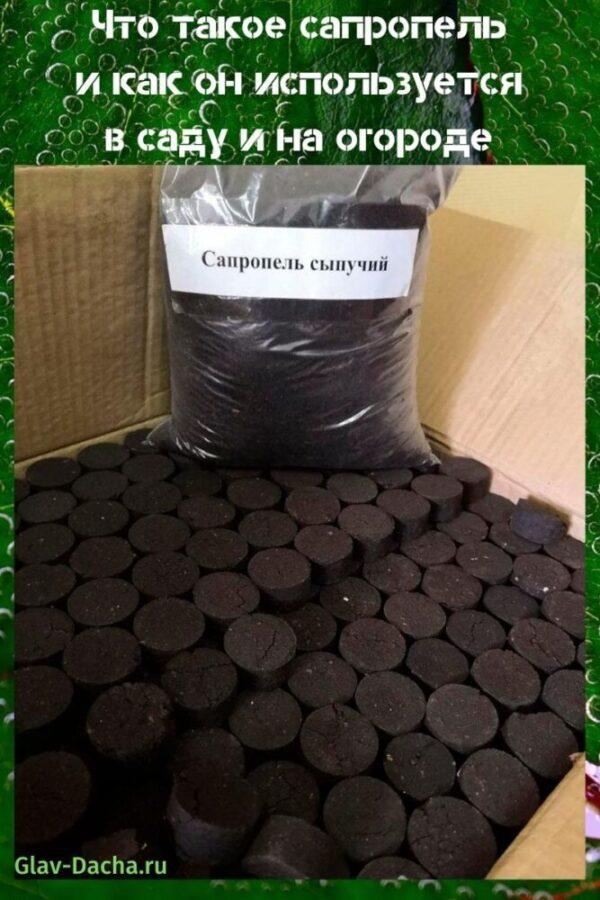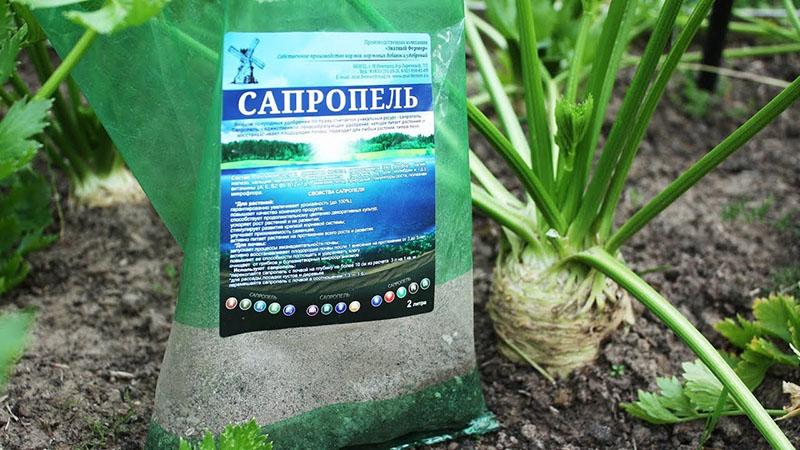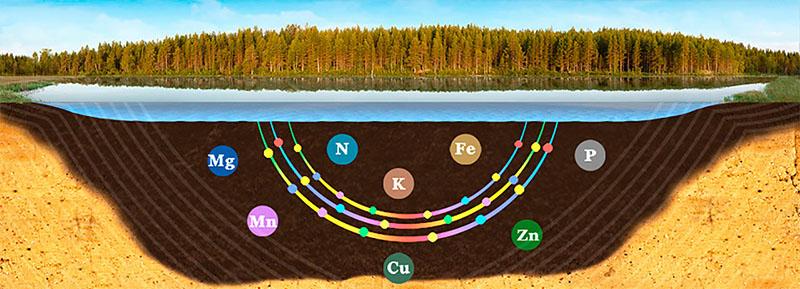What is sapropel and how is it used in the garden and in the garden
 Not all farmers who decide to use natural, safe and highly effective fertilizing on their personal plot or garden know what sapropel is and how it is used in crop production. These are layered bottom sediments that accumulate in freshwater lakes. They are widely used in the cultivation of both vegetable and fruit, berry and ornamental plants, as they effectively improve the composition of fertile soil, improve growth and increase the fruiting of crops.
Not all farmers who decide to use natural, safe and highly effective fertilizing on their personal plot or garden know what sapropel is and how it is used in crop production. These are layered bottom sediments that accumulate in freshwater lakes. They are widely used in the cultivation of both vegetable and fruit, berry and ornamental plants, as they effectively improve the composition of fertile soil, improve growth and increase the fruiting of crops.
What is sapropel and how is it used in crop production

Sapropel consists of dead algae, soil and the remains of microorganisms. The unique beneficial properties of this component are due to two main factors - stagnant water and limited air access.
Environmentally friendly fertilizer contains a huge amount of biologically active components:
- vitamins of group B, E, C;
- micro- and macroelements - copper, cobalt, manganese, bromine, phosphorus, potassium, sodium, nitrogen;
- a complex of enzymes, carotenoids and essential amino acids;
- humic acid.
 When deciding what sapropel is and where it is mined, they often confuse it with ordinary silt. The difference is that the sludge is formed in reservoirs with running water and has a poorer composition.
When deciding what sapropel is and where it is mined, they often confuse it with ordinary silt. The difference is that the sludge is formed in reservoirs with running water and has a poorer composition.
 Sapropel has a complex effect. It is used as a fertilizer. Microorganisms contained in it accelerate the accumulation and decomposition of humus, increasing soil fertility. Fertilizing improves the supply of nutrients to the roots of plants, stimulating their growth and productivity.
Sapropel has a complex effect. It is used as a fertilizer. Microorganisms contained in it accelerate the accumulation and decomposition of humus, increasing soil fertility. Fertilizing improves the supply of nutrients to the roots of plants, stimulating their growth and productivity.
Sapropel at their summer cottage
 There are several ways how to use sapropel in the garden and in the garden. Universal bottom sediments help to improve the structure of the soil, stimulate the development of vegetables, garden and ornamental plants at different stages of their growth.
There are several ways how to use sapropel in the garden and in the garden. Universal bottom sediments help to improve the structure of the soil, stimulate the development of vegetables, garden and ornamental plants at different stages of their growth.
Lake fertilizer can be used for many crops:
- cucumbers;
- tomatoes;
- zucchini;
- eggplant;
- bell pepper;
- White cabbage;
- watermelons.
Sapropel can also be used for seedlings - it makes them stronger and healthier, helps rooting.
Sapropel in the garden

The use of sapropel in the garden allows you to effectively disinfect fertile soil, activate the growth of vegetable crops, and also prevent the multiplication of pathogenic microorganisms.
Useful properties of sapropel:
- fertilization with lake sediments saturates vegetable crops with essential nutrients for the entire season;
- improves seed germination;
- increases the productivity of plants and improves the taste of fruits;
- stimulates the rooting and development of the root system in young shoots;
- strengthens the immune system of garden plants;
- after feeding with sapropel, the soil remains fertile for up to 4-6 years, which has a positive effect on the yield of vegetables.
 Sapropel as a fertilizer can be used at any stage of the plant growing season. To do this, the organic dressing should be spread evenly over the surface. For 1 sq. M.you need 3 liters of sapropel. After that, you need to dig up the soil to a depth of 10-13 cm.
Sapropel as a fertilizer can be used at any stage of the plant growing season. To do this, the organic dressing should be spread evenly over the surface. For 1 sq. M.you need 3 liters of sapropel. After that, you need to dig up the soil to a depth of 10-13 cm.
Also, organic fertilizer is often used to feed potatoes. Many gardeners claim that with the help of sapropel it is possible to increase the potato yield by 1.5-2 times. Bottom sediments are introduced into the soil before planting potatoes in a ratio of 3-4 liters per 1 m.
Sapropel for seedlings
 Sapropel for seedlings helps to strengthen them and ensure healthy, vigorous growth. For this, crop seeds must be sown in a substrate containing lacustrine sediments.
Sapropel for seedlings helps to strengthen them and ensure healthy, vigorous growth. For this, crop seeds must be sown in a substrate containing lacustrine sediments.
The fertilization ratio depends on the type of seedlings:
- Melons, squash and cucumbers - soil, sand and sapropel in a ratio of 6: 4: 3.
- Bell peppers, eggplants, tomatoes - seeds are sown into a substrate from soil, sand and sapropel in a ratio of 7: 2: 1.
- Leafy crops, spicy greens, white cabbage and cauliflower - soil, sand and sapropel in parts 2: 4: 3.
Before sowing seeds or transplanting seedlings of vegetable or ornamental plants to beds or in a flower garden, the soil can be additionally nourished. To do this, you need to dig up the soil to a depth of 7-10 cm and at the same time add sapropel (3 liters per 1 m).
Sapropel in the garden
 Sapropel is widely used in many household and garden plots, for better rooting of seedlings of fruit trees and berry bushes, their active growth and excellent fruiting.
Sapropel is widely used in many household and garden plots, for better rooting of seedlings of fruit trees and berry bushes, their active growth and excellent fruiting.
Instructions for using sapropel are very simple - during planting of seedlings, you need to pour a mixture of soil and sapropel (3: 1) into the holes. The advantage of such fertilization is a long-term effect, which lasts until the moment of fruiting and has a positive effect on crop yields.
Sapropel can also be used for feeding fruit trees and shrubs. For this purpose, the tree trunk circle should be sprinkled with a layer of sapropel up to 6-8 cm thick, for shrubs up to 2-3 cm. After that, the trunk space should be loosened and watered abundantly. Such feeding is recommended to be carried out no more than 2-3 times per season.
Sapropel for indoor plants
 Sapropel can be used to feed indoor plants. It is used as a substrate for planting or transplanting ornamental crops. To prepare it, 3 parts of high-quality garden soil must be mixed with 1 part of sapropel.
Sapropel can be used to feed indoor plants. It is used as a substrate for planting or transplanting ornamental crops. To prepare it, 3 parts of high-quality garden soil must be mixed with 1 part of sapropel.
Common mistakes when using
 In order for the use of sapropel to bring maximum benefit to the personal plot, common mistakes must be avoided.
In order for the use of sapropel to bring maximum benefit to the personal plot, common mistakes must be avoided.
The main ones are:
- Bottom sediments provide a long-term effect and increase soil fertility for up to 4-6 years. Therefore, there is no need to make them annually.

- Do not use sapropel as a mono-feeding. The best effect is obtained by using the substance in conjunction with other dressings containing phosphorus and other minerals.
- Failure to comply with the proportions - can cause serious harm to vegetables, fruit and berry crops.

Sapropel has a rich biochemical composition, so an excess of this fertilizer can oversaturate the plants, and a deficiency will not bring any benefit. Therefore, it is very important to respect the proportions indicated in the fertilizer instructions.
Sapropel mining
 Answering the question of gardeners, how is sapropel used and what it is, it is necessary to take into account the specific method of extracting this substance. It is obtained from the bottom of lakes with stagnant water using special, heavy equipment. Its use is necessary, since the organic material is located at a considerable depth.
Answering the question of gardeners, how is sapropel used and what it is, it is necessary to take into account the specific method of extracting this substance. It is obtained from the bottom of lakes with stagnant water using special, heavy equipment. Its use is necessary, since the organic material is located at a considerable depth.
 After extraction, the sapropel is completely dried. Wet particles of the material lead to the fact that the fertilizer deteriorates, its rotting begins and all useful properties are lost. Then the sapropel is crushed to a powdery state. Bottom sediments are sold in the form of dry powder, tablets or compressed granules.
After extraction, the sapropel is completely dried. Wet particles of the material lead to the fact that the fertilizer deteriorates, its rotting begins and all useful properties are lost. Then the sapropel is crushed to a powdery state. Bottom sediments are sold in the form of dry powder, tablets or compressed granules.
Self-mining of sapropel
 Do-it-yourself sapropel extraction is possible, but rather laborious. It is carried out in freshwater stagnant waters and marshy areas. The main difficulty in self-extraction of organic fertilizer is the lack of the necessary equipment.
Do-it-yourself sapropel extraction is possible, but rather laborious. It is carried out in freshwater stagnant waters and marshy areas. The main difficulty in self-extraction of organic fertilizer is the lack of the necessary equipment.
In such cases, handicraft sapropel extraction can be carried out using household tools and equipment. Most often, modified forks are used - an ordinary garden tool must be wrapped with wire to create a kind of lattice shovel.
 It is convenient to use a homemade tool to lift organic deposits from the bottom. After that, they should be dried, grinded or chopped in another way and poured into containers for further storage.
It is convenient to use a homemade tool to lift organic deposits from the bottom. After that, they should be dried, grinded or chopped in another way and poured into containers for further storage.
Sapropel is a natural, environmentally friendly and safe broad-spectrum substance. When used correctly, it improves the structure and fertility of the soil, ensures rapid rooting of seedlings, vigorous growth and high plant productivity.